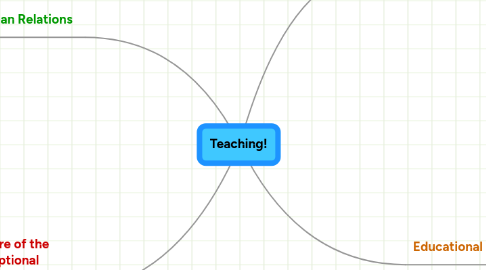
1. Human Relations
1.1. Use the Multiple Dimensions of Our Identity for an icebreaker
1.1.1. Have the student write their name and create a bubble around it, then, have them branch off in four different directions to other bubbles with one word that describes them. After, have each student share with a partner or group.
1.2. Ethnocentrism
1.2.1. the tendency to judge other's from their own perspective
1.3. "How can we hope to teach cross-culturally when we lack the basic knowledge about the students we hope to educate?"
1.3.1. Teachers need to be sensitive to all their students' cultural identities
1.4. Adaptation
1.4.1. Inflexibility for adapting lesson plans to fit all students alienates students from different cultures
2. Nature of the Exceptional Child
2.1. Least Restrictive Environment: students have the right to be taught in a setting with students of equal intelligence
2.2. EBD: Emotional Behavior Disorder
2.3. SLD: Specific Learning Disability
2.4. RTI: Response to Intervention
2.5. CO: Cognitive Disability
2.5.1. Two Factors:IQ score of 70 and below and Severe concern in adaptive behavior
2.6. IEP
2.6.1. Individual Educational Plan
2.6.1.1. Federally Funded Results from referrall process Team involvement Must be reviewed annually Special Ed teacher involved
3. Foundations of Education
3.1. classroom should be more democratic and less authoratative
3.2. Do not post a list of rules
3.3. "everything is a teacher-related issue"
3.4. Groups can be any size and have the same topic
3.4.1. Just because two groups have the same topic doesn't mean they will achieve the same outcome
3.5. notecards are the most valuable tool a teacher can have!
3.5.1. You can have the students list their name, top multiple intelligence, learning style and other information that will help you help them learn
3.6. Share control with students
3.6.1. Give students options!
4. Educational Psychology
4.1. Piaget
4.1.1. Four stages of Development: Sensorimotor, Preoperational, Concrete, and Formal Operations
4.2. Maslow
4.2.1. Hierarchy of Needs
4.2.1.1. Physiological, Safety, Love and Belonging, Esteem and Self-Actualization
4.3. Watson
4.3.1. Law of Recency: “The response that has most recently occurred after a particular stimulus is the response most likely to be associated with that stimulus.”
4.3.2. Law of Frequency: “The more frequently a stimulus and response occur in association with each other, the stronger that S-R habit will become.”
4.4. SODA
4.4.1. S-Identify the Situation O-Identify the Options D-Identify the Disadvantages A-Identify the Advantages S-Choose a Solution
